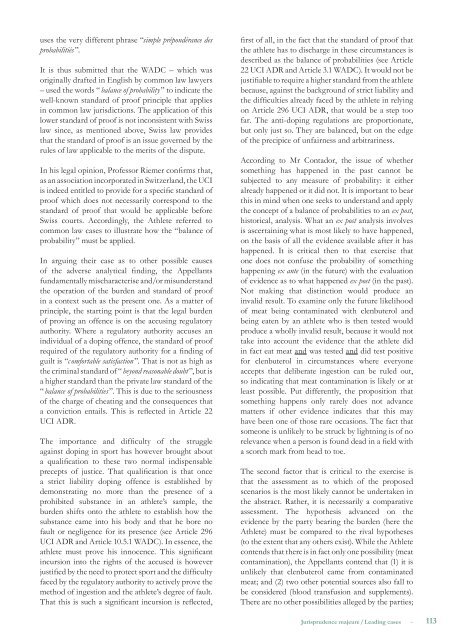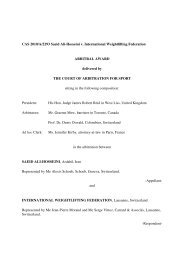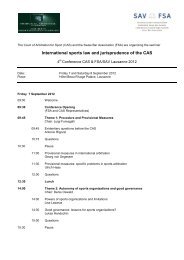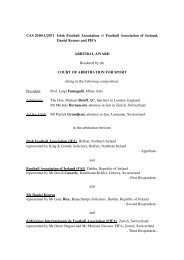(CAS) Bulletin - Tribunal Arbitral du Sport / TAS
(CAS) Bulletin - Tribunal Arbitral du Sport / TAS
(CAS) Bulletin - Tribunal Arbitral du Sport / TAS
Create successful ePaper yourself
Turn your PDF publications into a flip-book with our unique Google optimized e-Paper software.
uses the very different phrase “simple prépondérance des<br />
probabilitiés ”.<br />
It is thus submitted that the WADC – which was<br />
originally drafted in English by common law lawyers<br />
– used the words “ balance of probability ” to indicate the<br />
well-known standard of proof principle that applies<br />
in common law jurisdictions. The application of this<br />
lower standard of proof is not inconsistent with Swiss<br />
law since, as mentioned above, Swiss law provides<br />
that the standard of proof is an issue governed by the<br />
rules of law applicable to the merits of the dispute.<br />
In his legal opinion, Professor Riemer confi rms that,<br />
as an association incorporated in Switzerland, the UCI<br />
is indeed entitled to provide for a specifi c standard of<br />
proof which does not necessarily correspond to the<br />
standard of proof that would be applicable before<br />
Swiss courts. Accordingly, the Athlete referred to<br />
common law cases to illustrate how the “balance of<br />
probability” must be applied.<br />
In arguing their case as to other possible causes<br />
of the adverse analytical fi nding, the Appellants<br />
fundamentally mischaracterise and/or misunderstand<br />
the operation of the burden and standard of proof<br />
in a context such as the present one. As a matter of<br />
principle, the starting point is that the legal burden<br />
of proving an offence is on the accusing regulatory<br />
authority. Where a regulatory authority accuses an<br />
indivi<strong>du</strong>al of a doping offence, the standard of proof<br />
required of the regulatory authority for a fi nding of<br />
guilt is “c omfortable satisfaction ”. That is not as high as<br />
the criminal standard of “ beyond reasonable doubt ”, but is<br />
a higher standard than the private law standard of the<br />
“ balance of probabilities ”. This is <strong>du</strong>e to the seriousness<br />
of the charge of cheating and the consequences that<br />
a conviction entails. This is refl ected in Article 22<br />
UCI ADR.<br />
The importance and diffi culty of the struggle<br />
against doping in sport has however brought about<br />
a qualifi cation to these two normal indispensable<br />
precepts of justice. That qualifi cation is that once<br />
a strict liability doping offence is established by<br />
demonstrating no more than the presence of a<br />
prohibited substance in an athlete’s sample, the<br />
burden shifts onto the athlete to establish how the<br />
substance came into his body and that he bore no<br />
fault or negligence for its presence (see Article 296<br />
UCI ADR and Article 10.5.1 WADC). In essence, the<br />
athlete must prove his innocence. This signifi cant<br />
incursion into the rights of the accused is however<br />
justifi ed by the need to protect sport and the diffi culty<br />
faced by the regulatory authority to actively prove the<br />
method of ingestion and the athlete’s degree of fault.<br />
That this is such a signifi cant incursion is refl ected,<br />
fi rst of all, in the fact that the standard of proof that<br />
the athlete has to discharge in these circumstances is<br />
described as the balance of probabilities (see Article<br />
22 UCI ADR and Article 3.1 WADC). It would not be<br />
justifi able to require a higher standard from the athlete<br />
because, against the background of strict liability and<br />
the diffi culties already faced by the athlete in relying<br />
on Article 296 UCI ADR, that would be a step too<br />
far. The anti-doping regulations are proportionate,<br />
but only just so. They are balanced, but on the edge<br />
of the precipice of unfairness and arbitrariness.<br />
According to Mr Contador, the issue of whether<br />
something has happened in the past cannot be<br />
subjected to any measure of probability: it either<br />
already happened or it did not. It is important to bear<br />
this in mind when one seeks to understand and apply<br />
the concept of a balance of probabilities to an ex post,<br />
historical, analysis. What an ex post analysis involves<br />
is ascertaining what is most likely to have happened,<br />
on the basis of all the evidence available after it has<br />
happened. It is critical then to that exercise that<br />
one does not confuse the probability of something<br />
happening ex ante (in the future) with the evaluation<br />
of evidence as to what happened ex post (in the past).<br />
Not making that distinction would pro<strong>du</strong>ce an<br />
invalid result. To examine only the future likelihood<br />
of meat being contaminated with clenbuterol and<br />
being eaten by an athlete who is then tested would<br />
pro<strong>du</strong>ce a wholly invalid result, because it would not<br />
take into account the evidence that the athlete did<br />
in fact eat meat and was tested and did test positive<br />
for clenbuterol in circumstances where everyone<br />
accepts that deliberate ingestion can be ruled out,<br />
so indicating that meat contamination is likely or at<br />
least possible. Put differently, the proposition that<br />
something happens only rarely does not advance<br />
matters if other evidence indicates that this may<br />
have been one of those rare occasions. The fact that<br />
someone is unlikely to be struck by lightning is of no<br />
relevance when a person is found dead in a fi eld with<br />
a scorch mark from head to toe.<br />
The second factor that is critical to the exercise is<br />
that the assessment as to which of the proposed<br />
scenarios is the most likely cannot be undertaken in<br />
the abstract. Rather, it is necessarily a comparative<br />
assessment. The hypothesis advanced on the<br />
evidence by the party bearing the burden (here the<br />
Athlete) must be compared to the rival hypotheses<br />
(to the extent that any others exist). While the Athlete<br />
contends that there is in fact only one possibility (meat<br />
contamination), the Appellants contend that (1) it is<br />
unlikely that clenbuterol came from contaminated<br />
meat; and (2) two other potential sources also fall to<br />
be considered (blood transfusion and supplements).<br />
There are no other possibilities alleged by the parties;<br />
Jurisprudence majeure / Leading cases<br />
-<br />
113





